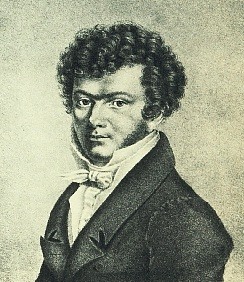(28 November 1784 [baptised] – 13 January 1838)
was a German composer. Ries was a friend, pupil and secretary of Ludwig van Beethoven.
He composed eight symphonies, a violin concerto, eight piano concertos, three operas, and numerous other works in many genres, including 26 string quartets.
Quintet for piano, violin, viola, cello, and double bass, in B minor, Op.74
Nepomuk Fortepiano Quintet: Riko Fukuda, fortepiano, Franc Polman, violin, Elisabeth Smalt, viola, Jan Insinger, cello, Pieter Smithuijsen, double bass
1.Grave – Allegro con brio – 00:00
2.Larghetto – 09:22
3.Rondo: Allegro – Andantino – Allegro – 14:20
As one of the greatest pianists in Europe of his time and a composer of exceptional ability it is surprising that the name Ferdinand Ries is not better known today. Indeed, the neglect of most of his major works is even more inexplicable given his long association with Beethoven. In most other circumstances this would have prompted an exhaustive study of his music but in Ries's case this has not happened. one of the reasons for this may lie in his publication of an important book of reminiscences about Beethoven which has proved to be of such compelling interest to scholars that they have concentrated on it rather than his music. Of his own career comparatively little has been written. Over the years there have been sporadic performances and recordings of some of Ries's chamber works and, more recently, of his very impressive symphonies and piano concertos.
“The Quintet Op.74 for violin, viola, cello, double bass and piano was published in London in 1817. The first movement (Grave) begins with a lamento, in which the piano plays a recitative, with melodic elements that are closely related to Hungarian folk music. In the Allegro con brio that follows, one bravura piano passage follows the other, while the strings only play a subordinate role. Ries was a piano virtuoso whose talent won him international admiration, and this movement showcases his command of piano writing. The Larghetto begins with a cello solo, accompanied only by the piano, after which the piano takes up the theme and its variations. Several cadenza-like passages interrupt the music and eventually lead into the third movement, the Rondo. After an Allegro with a brilliant piano part, there is a calm interlude that effectively evokes a medieval atmosphere. Its melody is alternately performed by the strings playing pizzicato and by the piano. The transition back to the original theme of the Rondo leads through technically demanding passages that run into the thunderous finale.” (from Album Notes by Riko Fukuda)
'♣ 음악 감상실 ♣ > - 페르디난드 리스' 카테고리의 다른 글
| Ferdinand Ries - 변주곡[Variation] 모음 (0) | 2020.01.26 |
|---|---|
| Ferdinand Ries: Introduction et Rondo Brillant, Op.144(1825; publ. 1828) (0) | 2020.01.25 |
| Ferdinand Ries - Symphony No. 1, 2, 3, 4 (0) | 2019.11.17 |
| Ferdinand Ries - Symphony 5, 6, 7 번 (0) | 2019.11.16 |
| Ferdinand Ries - Grand Otetto Op. 128 (0) | 2019.11.15 |
